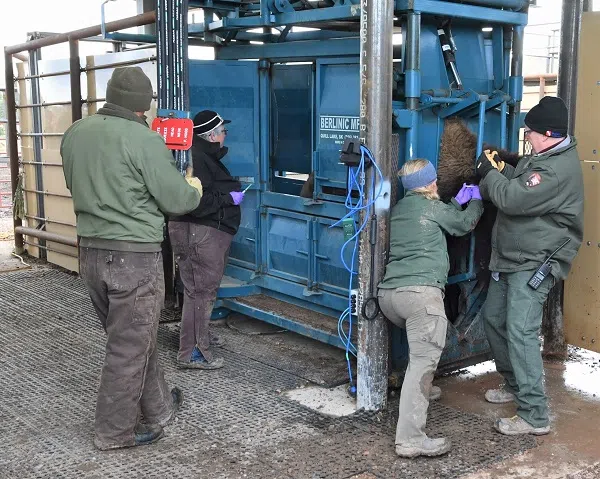Wind Cave’s new bison handling facility was used for the first time during the park’s biennial bison capture operation conducted the week of October 11 as 390 animals were processed through it with 118 excess yearlings and two-year old bison sent to new homes. The 16-pen corrals were constructed to provide a safer environment for animals and the employees working the operation.
“These new corrals were designed to provide a low stress environment for the bison,” said Park Superintendent Leigh Welling. “This is a groundbreaking facility for the National Park Service, and it can be used as a model for safe animal handling techniques by other parks.”
Every other year the park conducts a capture operation to help manage the population of the herd for health and sustainability purposes. Excess young bison are distributed through agreements and partnerships to Tribes and agencies to help develop strong conservation herds and maintain traditional uses of bison in the country. The park manages one of the most highly sought-after bison herds in North America because of its genetic integrity and diversity. After this operation, Wind Cave’s bison population is approximately 400 animals.
Through the coordination of the InterTribal Buffalo Council (ITBC), approximately 40 animals went to four tribes (Red Lake Band of Chippewa Indians, Minnesota; Sisseton Wahepton Oyate, South Dakota; Pueblo of Pojoaque, New Mexico; Prairie Band Potawatomi Nation, Kansas). Over the years, working with ITBC has helped restore bison to many of their native homelands.
The Wolakota Buffalo Range of the Rosebud Sioux received 60 bison to bolster their herd on their 28,000 acres of grasslands.
The Nature Conservancy received approximately 15 bison to supplement their preserve herds at Nachusa Prairie, Illinois, and Kankakee Sands, Indiana.
The Red River Zoo in Fargo received three animals as part of a Zoo-Park Partnership for America’s Keystone Wildlife and for a chance for the zoo to play a direct role in bison restoration.
All other captured bison were released back into the park after ensuring each animal had been microchipped. If not, a small microchip was implanted under the skin of each animal allowing biologists to identify the animal during future capture operations.
The park collects data on the animal’s sex, age, and genetics. This year, 100 animals were tested for mycoplasma bovis, a pathogen that causes respiratory disease, mastitis, and arthritis in bovine species. This is part of a study to assess the prevalence of this disease the National Park Service is doing in collaboration with South Dakota State University and the University of Wyoming.
The design for the new corrals incorporates several features suggested by Whit Hubbard, a specialist in this field. Among the improvements that lessoned the stress on the animals included reducing opportunities where bison can see people, improving movement through the corrals, and increasing the size of the holding pens.

Biological Science Technician, Hollie Lybarger-Pucket, inserts a microchip while Tim Franklin, Maintenance Worker, holds the head of the bison. Maintenance Worker Greg August stands by controlling the squeeze chute and Amy Bandel, DMV, from the US Department of Agriculture, Animal and Plant Health Inspection Service, prepares to draw a blood sample.
Photo credit National Park Service.







Comments